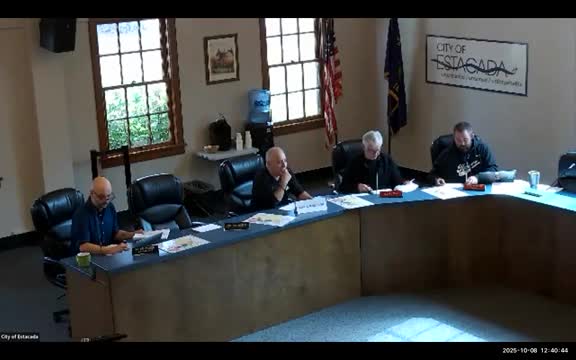Council‑initiated sign code rewrite clears planning commission; ordinance streamlines rules and exempts temporary signs from permitting
October 08, 2025 | Estacada, Clackamas County, Oregon
This article was created by AI summarizing key points discussed. AI makes mistakes, so for full details and context, please refer to the video of the full meeting. Please report any errors so we can fix them. Report an error »

The Planning Commission on Oct. 8 recommended approval of Ordinance 2025‑008, a comprehensive rewrite and reorganization of the Estacada sign code (EMC 16.72) and related citations in the city development code. The commission voted 5‑0 to forward the revised ordinance to city council for adoption.
What changed
Planning staff said the current sign code is difficult for applicants and staff to interpret and contains contradictory and content‑based language. The proposed ordinance reorganizes 16.72, clarifies and expands definitions related to signage, removes legally vulnerable content‑based restrictions where feasible, and adds a picture glossary (sign types and allowances table) to assist applicants and reviewers.
Temporary signs and political content
Council had earlier directed staff to exempt political signs from permitting. In the new draft, staff recommended exempting all temporary signs from permit requirements but retaining time/space/manner restrictions (size, time on display, and where they may be posted) so the city can regulate duration and placement without regulating content. Under the draft, staff said a typical temporary sign (including election‑period or issue signs) would be exempt from a permit but subject to maximum duration limits (for example, posted no more than six months in a given allowance) and size limits depending on zone.
Flags and other clarifications
The draft retains exemptions for flags but staff noted older code language that references “nationally recognized” flags and said they would revisit that specific phrasing with the city attorney and manager; staff proposed simplifying language so ordinary flags are clearly allowed while preserving reasonable public‑safety and size limitations. Staff also clarified which signage is exempt because it is integral to an on‑site use (for example, a sign on a trailer that indicates the structure’s use) and therefore not subject to a separate sign permit.
Approval criteria and next steps
Planning staff reviewed statewide planning goals, the comprehensive plan (downtown policy language calling for pedestrian‑scale signage and prohibiting large auto‑oriented signs), and development code requirements and concluded the amendments are consistent with applicable policies. The commission voted 5‑0 to recommend approval; the ordinance will be forwarded to city council for final action.
Ending
If council adopts the ordinance, the new sign chapter and related code edits will take effect according to the formal ordinance schedule. Staff told commissioners supplemental materials, including figures and a sign glossary, will be made available to applicants to aid compliance.
What changed
Planning staff said the current sign code is difficult for applicants and staff to interpret and contains contradictory and content‑based language. The proposed ordinance reorganizes 16.72, clarifies and expands definitions related to signage, removes legally vulnerable content‑based restrictions where feasible, and adds a picture glossary (sign types and allowances table) to assist applicants and reviewers.
Temporary signs and political content
Council had earlier directed staff to exempt political signs from permitting. In the new draft, staff recommended exempting all temporary signs from permit requirements but retaining time/space/manner restrictions (size, time on display, and where they may be posted) so the city can regulate duration and placement without regulating content. Under the draft, staff said a typical temporary sign (including election‑period or issue signs) would be exempt from a permit but subject to maximum duration limits (for example, posted no more than six months in a given allowance) and size limits depending on zone.
Flags and other clarifications
The draft retains exemptions for flags but staff noted older code language that references “nationally recognized” flags and said they would revisit that specific phrasing with the city attorney and manager; staff proposed simplifying language so ordinary flags are clearly allowed while preserving reasonable public‑safety and size limitations. Staff also clarified which signage is exempt because it is integral to an on‑site use (for example, a sign on a trailer that indicates the structure’s use) and therefore not subject to a separate sign permit.
Approval criteria and next steps
Planning staff reviewed statewide planning goals, the comprehensive plan (downtown policy language calling for pedestrian‑scale signage and prohibiting large auto‑oriented signs), and development code requirements and concluded the amendments are consistent with applicable policies. The commission voted 5‑0 to recommend approval; the ordinance will be forwarded to city council for final action.
Ending
If council adopts the ordinance, the new sign chapter and related code edits will take effect according to the formal ordinance schedule. Staff told commissioners supplemental materials, including figures and a sign glossary, will be made available to applicants to aid compliance.
View the Full Meeting & All Its Details
This article offers just a summary. Unlock complete video, transcripts, and insights as a Founder Member.
✓
Watch full, unedited meeting videos
✓
Search every word spoken in unlimited transcripts
✓
AI summaries & real-time alerts (all government levels)
✓
Permanent access to expanding government content
30-day money-back guarantee

